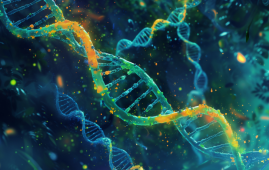

Understanding how the body adjusts to the intense energy demands of nursing has long been a subject of scientific curiosity. Now, a landmark lactation metabolism study published in Nature Metabolism uncovers the brain-based mechanism that helps mothers balance hormonal changes and metabolic needs during breastfeeding.
Researchers from Baylor College of Medicine and Pennington Biomedical Research Center have identified how the brain orchestrates the interplay between prolactin, estrogen, and energy conservation to sustain milk production.
How the Brain Adapts to the Metabolic Demands of Lactation
“Nursing mothers need to eat more and burn less fat to meet the demands of milk production,” said Dr. Chunmei Wang, co-corresponding author and assistant professor of pediatrics at Baylor. “We used animal models to investigate how the brain and hormones adapt to this challenge.”
The lactation metabolism study reveals a compelling hormonal shift: estrogen levels decrease, while prolactin levels increase. Estrogen typically curbs appetite and promotes fat burning, whereas prolactin does the opposite. The reversal of these functions enables the body to prioritize milk synthesis.
Estrogen Receptor Neurons Play a Central Role in Lactation Metabolism
Key to this adaptation are estrogen receptor α (ERα) neurons in the hypothalamus. During lactation, these neurons become less active, contributing to increased hunger and energy conservation.
“We showed that removing ERα from this specific brain region causes prolactin to surge and metabolic behavior to mimic lactation—more eating and less fat burning—even in non-lactating mice,” explained Dr. Meng Yu, co-first author and postdoctoral associate in the Wang Lab.
“Reactivating these ERα neurons in lactating mice reversed those effects, confirming their critical role in metabolic control,” added Dr. Yanlin He, co-corresponding author at Pennington Biomedical.
A New Mechanism in Prolactin Regulation During Lactation
Traditionally, prolactin was thought to be regulated only at the pituitary level. This study adds a new layer: estrogen’s activation of ERα neurons in the hypothalamus plays a suppressive role in prolactin regulation. This brain-hormone interaction creates a precise balance to support maternal metabolism.
“This is a novel mechanism,” Dr. Wang noted. “Understanding how the hypothalamus regulates prolactin through estrogen opens doors to clinical applications.”
Broader Implications for Health Beyond Lactation
The implications of these findings extend well beyond lactation. They offer valuable insights for conditions such as hyperprolactinemia, obesity, menopause, and other metabolic disorders related to hormonal imbalance.
“This is not just about lactation metabolism,” said Dr. He. “This study opens up new avenues to understand how the brain integrates hormonal cues to regulate energy balance across many stages of life.”
For more information: Yu, M., et al. (2025). Suppression of hypothalamic oestrogenic signal sustains hyperprolactinemia and metabolic adaptation in lactating mice. Nature Metabolism. doi.org/10.1038/s42255-025-01268-z.
more recommended stories
 Phage Therapy Study Reveals RNA-Based Infection Control
Phage Therapy Study Reveals RNA-Based Infection ControlKey Takeaways (Quick Summary) Researchers uncovered.
 Pelvic Floor Disorders: Treatable Yet Often Ignored
Pelvic Floor Disorders: Treatable Yet Often IgnoredKey Takeaways (Quick Summary) Pelvic floor.
 Urine-Based microRNA Aging Clock Predicts Biological Age
Urine-Based microRNA Aging Clock Predicts Biological AgeKey Takeaways (Quick Summary) Researchers developed.
 Circadian Control of Neutrophils in Myocardial Infarction
Circadian Control of Neutrophils in Myocardial InfarctionKey Takeaways for HCPs Neutrophil activity.
 E-Cigarette Use and Heart Attack Risk in Former Smokers
E-Cigarette Use and Heart Attack Risk in Former SmokersKey Takeaways for Clinicians and Nurses.
 36-Week Pre-eclampsia Screening May Reduce Term Risk
36-Week Pre-eclampsia Screening May Reduce Term RiskA New Preventive Strategy for Term.
 Cardiovascular Risk and Sudden Cardiac Death in Diabetes
Cardiovascular Risk and Sudden Cardiac Death in DiabetesRising Sudden Cardiac Death (SCD) Risk.
 Poor Kidney Function and Alzheimer’s Biomarkers Explained
Poor Kidney Function and Alzheimer’s Biomarkers ExplainedPoor kidney function may influence levels.
 Walking Speed Before Hip Replacement Predicts Recovery
Walking Speed Before Hip Replacement Predicts RecoveryNew Evidence Points to a Simple,.
 Neuroblastoma Drug Combo Extends Survival in Models
Neuroblastoma Drug Combo Extends Survival in ModelsA Promising Shift in High-Risk Neuroblastoma.

Leave a Comment